Best Indoor Rowing Shoes
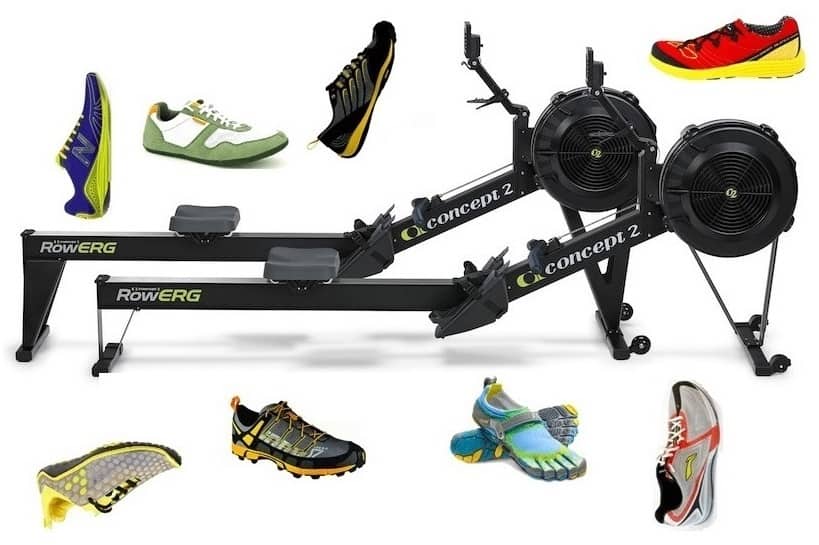
Minimalist trainers
The WHITIN Minimalist Trainers, available in a range of sizes and colors, have proven to be a great choice for indoor rowing. Their zero-drop, flat sole design closely mimics the feeling of being barefoot, offering a natural, balanced stance on the rowing machine. This is particularly beneficial for maintaining proper posture during intense rowing sessions.
The wider than usual toe box is a standout feature, allowing for natural toe spread which is essential when you need a strong, stable push-off in rowing. Additionally, the removable sockliner is a thoughtful addition, giving the option for a more connected feel with the machine, which some rowers might prefer for better technique and foot awareness.
Durability is another strong point. The true rubber sole provides substantial protection and grip, both on and off the rowing machine. This durability extends to the overall construction of the shoes, which have held up well under the stress of repetitive rowing motions.
They are a handy choice, since you can use them for other things than just rowing. You can comfortably do your weightlifting workout in these, and hit the grocery store after. You even run in them, but if you haven’t ran in minimalist shoes before, please take care, since it can be quite hard on your joints.
Overall, the WHITIN Minimalist Trainers are a great choice for indoor rowing enthusiasts. Their balance of comfort and durability makes them a noteworthy option for rowers looking for optimal performance.
Flat-soled shoes
The classic low-top sneaker features a durable canvas upper and an iconic silhouette. It's designed with an OrthoLite insole for enhanced comfort and a diamond outsole tread for superior traction. It's a great choice for rowing, and also works well for weightlifting.
- Classic style usable anywhere
- Plenty of colors available
- Completely flat sole
- Quite stiff for other sports outside of rowing and weightlifting
In the world of indoor rowing, Converse Chuck Taylor All-Stars have carved out a niche for themselves, renowned for their effectiveness in activities where a flat sole is essential.
These iconic shoes are a stellar pick for rowers, thanks to their ultra-thin soles that maximize power transfer and enhance the rowing stroke’s feel.
Lightweight and flexible, Chuck Taylors offer comfort that’s hard to match, especially in shoes designed for physical activity. While they might not excel in ventilation, their overall performance in indoor rowing sessions overshadows this minor drawback.
Affordability is another strong suit of the All-Stars. They strike an appealing balance between cost and quality, making them a sensible choice for rowers on a budget.
Overall, the Converse Chuck Taylor All-Stars are a sound choice for indoor rowing enthusiasts. They’re praised not just for rowing but also for other activities that benefit from a flat sole, like weightlifting, underscoring their versatility and enduring popularity.
Other alternatives
There are many other shoes that do the job for indoor rowing. The most important thing is that the shoe has a flat, thin sole. That way your foot placement is going to be optimal and you get a good feel for your drive and stroke.
If the shoes are also breathable and flexible, all the better.
Here are a few good alternatives.
Similar to the Converse All-Stars, these shoes offer a thin, flat sole with a rubber grip. Excellent alternative for rowing, if you prefer the look over that of the Converse.
Indoor soccer shoes work well for rowing, as they come with a flat, thin sole and they are quite flexible. The sole is rubber for a good grip.
It's almost like being barefoot, but with a bit of protection and a better grip. These shoes give you a great feel for the rowing machine.
How To Choose a Rowing Shoe
Many rowers don’t even question what they have on their feet before a rowing session.
While choosing what rowing shoe to wear can be difficult, it really comes down to experimentation and personal preference.
There are a lot of different variables that come into play and your shoe will change depending on the type of training you are performing.
How The Sole Affects Your Rowing
There are 3 points of contact on the rowing machine: hands, butt, and feet. All 3 have their own issues when it comes to protecting them, especially the feet.
Unlike running, which is high-impact, rowing has very low impact on the feet and joints. This is our first indication that what you wear on your feet running should probably not be the same as what you wear to row.
Running shoes have thick, cushioned soles and are made to absorb the impact of running on concrete. While this cushion is good for running, it’s completely unnecessary for rowing.
Extra cushion on your shoes can lead to a less efficient rowing stroke and also effect the angle of your feet, which can change your bio-mechanics.
Take a look at the shoes below. Each shoe style has their own unique features.
The style on the left has a thick heel cushion and becomes thinner near the toes. We call this a large “Heel-to-Toe Drop”. The middle shoe has a thick shoe sole but actually has a zero heel-to-toe drop. The shoe on the right has very little cushion and a zero heel-to-toe drop.

Choosing between these 3 choices of indoor rowing shoes can effect factors such as foot placement, form, comfort, and power.
Now if you are a casual rower who doesn’t care about improving times or you like running before or after you row, then regular running shoes might be fine.
But if you want optimal performance, the shoes you wear can really make a difference. I even talk about this as the “Law of Marginal Gains” in my best advice for rowing a 2K article.
Foot Positioning
The shoes you wear have a big impact on your foot placement, which affects your rowing stroke.
Placing your feet too high will limit your forward movement and cause incorrect rowing form. It will shorten your overall rowing stroke and not give you the forward reach that you need.
Placing your feet too low will cause improper leg drive and a weak power position. It can also put added stress on your lower back making for an uncomfortable session.
A large cushion and big heel-to-toe drop can also cause a change in the angle of your feet.
If you look at the placement of the foot-boards of most rowing machines you will see they is set at approximately a 45 degree angle (+ or – a few degrees). This is close to optimal for rowing but can be adjusted when athletes reach more serious levels.
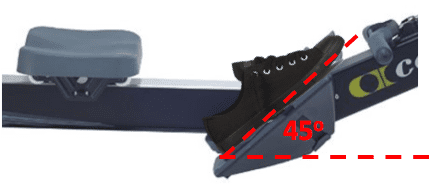
Depending on what indoor rowing machine shoe you wear can cause this angle to change. An erg shoe with a zero drop will have no effect but a running shoe with a large heel-to-toe drop will. See the photo below.

A shoe with a big heel-to-toe drop will decrease the angle that your foot pushes off the foot-board, which can lead to comfort and form issues. An angle that is too shallow or small can also lead to decreased power and efficiency which I mention below.
If your flexibility and form will permit a larger foot-board angle it may lead to better erg times.
Read more: Proper Rowing Machine Foot Position
The type of rowing machine shoes you wear will change the setting or hole of the foot cup. From rowing with running shoes to barefoot rowing, there is usually a one to two hole difference in setting.
The main point of this section is to show that when jumping on an erg you must give some thought to what shoe you are wearing and your foot placement. If you just jump on and begin rowing you may not have your feet in the optimal position.
Power and Efficiency
Using the wrong type of rowing will result in a loss of efficiency and power.
Using running shoes with a lot of cushion could reduce the amount of force being applied to your leg drive.
As previously mentioned, it can affect the angle at which you push off the foot-boards which can lead to less power.
Another issue when you go to push off the footrests with running shoes is the thick heel compresses and absorbs energy. This absorbed energy does not get transferred to the leg drive and is never recovered during the rowing stroke.
While the amount of energy may be small it can add up very quickly if you are doing long sessions.
You can see the amount of compression a running shoe has from photos taken before and after ground contact when running.
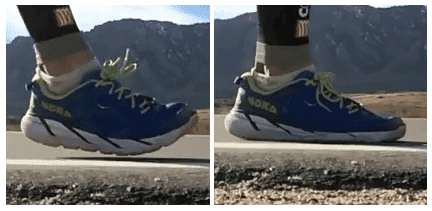
While this compression and absorption is good for running it will lead to lost power in rowing.
Running shoes also have an uneven sole which is made for compressing at various points during a running stride. This may cause the user to push off the foot board unevenly and have a less efficient stroke. A shoe with less padding and more parallel connection to the foot board would allow for a stronger, more efficient drive.
Cyclists and weightlifters wear thin-soled shoes for the same reason. They want to have the lowest amount of cushion between their body and the object they are applying force to. This increases the efficiency of the power transition and gives the athlete a better feel for their form.
Flexibility
Flexibility is a factor you don’t want to overlook when looking for the best indoor rowing shoes. First, it allows you to feel your foot position on the footboards.
Inflexible shoes can also cause discomfort when try to get into the catch position. Your shoes should not get in the way of allowing your shins to be vertical in the catch position.
Flexibility also comes in handy to allow you to splay your toes in the toe box. You want your toes and foot muscles to move unrestricted in your indoor rowing shoes.
Breathability
Rowing is very strenuous so wearing heavy, thick-clothed shoes can cause your feet to sweat excessively.
You want to check the breathability of the upper part of the shoes. It’s more comfortable to row if there’s plenty of airflow in the shoe to cool your feet.
Additionally, breathable shoes keep your feet fresh as fresh air rushes in to prevent foot odor. Usually, shoes boasting an upper mesh construction are more breathable.
Durability
Most people think that only running shoes demand durability, but even indoor rowing shoes do. The outsoles are in constant contact with the footboards, rubbing on them with each drive. If you want to prevent premature wear on the outsoles, choose shoes with durable outsoles.
The outsoles take a beating more than any component of the shoes. Therefore, you want to ensure your chosen indoor rowing shoes are durable, especially at the outsoles. Of course, the upper unit should also be durable and doesn’t fray prematurely.
Since you will row for many years, you want shoes that last you the entire time. So, check for durability before buying any rowing shoe brand.
Frequently Asked Questions
What Is the Best Heel-to-Toe Drop for Rowing Shoes?
A zero-millimeter heel-to-toe drop is best for indoor rowing shoes. Usually, shoes have cushioning materials placed beneath your heels and the forefoot section. Sometimes, a difference in the cushioning in these two areas could result in the heel rising above the forefoot section by a few millimeters.
But if the heel and the forefoot sections have cushioning of the same amount, they will be on the same level. And this means the heel-to-toe drop will be zero. Since using an indoor rower requires shoes with a zero drop, you want to ensure your chosen shoes have a flat sole.
Besides looking for zero-drop rowing shoes, you also want to check if their outsoles are thin. There is a good reason why you want to settle on thin-soled rowing shoes.
First, rowing is a low-impact activity, unlike running, that puts a lot of pressure on your knees and joints. With this in mind, you don’t need thick outsoles since your knees will barely feel any impact.
Moreover, thick-soled shoes absorb more power, limiting power transfer to the footrests. That means thick outsoles absorb power when pushing against the footboards to perform a rowing stroke.
As a result, you will experience a reduced power efficiency if you wear thick-soled shoes. Therefore, you want to wear flat soled shoes and ensure they feature thin outsoles for efficient power transfer to the footboards.
Why Do the Outsoles Need to Be Thin For Indoor Rowing Machines?
First, the outsoles should be thin to transfer as much power to the footboards as possible. Indoor rowing shoes with thin outsoles are your best option for increasing your rowing efficiency.
That’s because such shoes don’t absorb much of the generated power, transferring more power for an efficient rowing stroke.
Second, thin soled rowing shoes allow you to feel the footboards more, giving you a better understanding of foot placement on the footboards. As a result, you will channel power to the rowing machine better.
Therefore, you want to opt for thin soled shoes for your rowing machine.

Rowing Machine King Founder and Author.

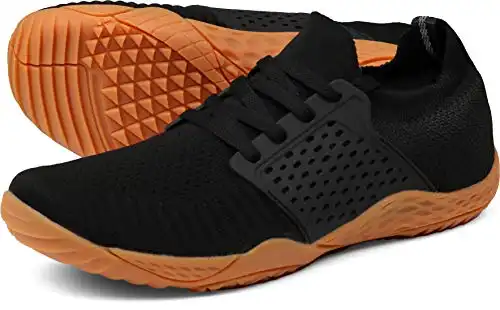
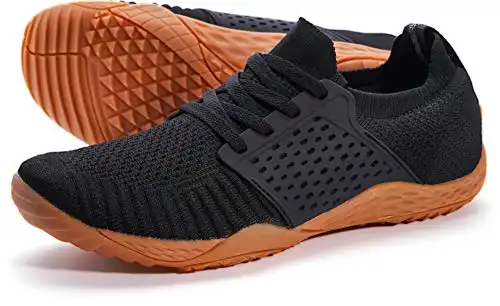
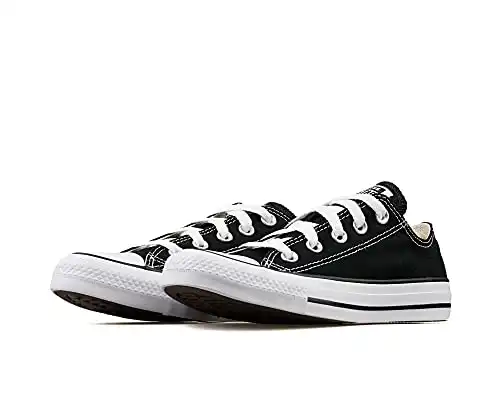
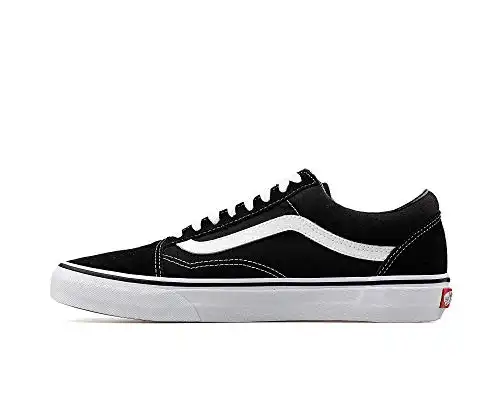
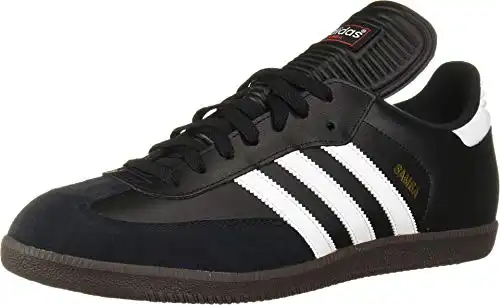
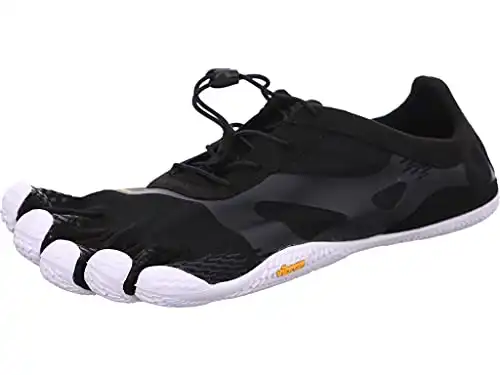
I’ve been indoor rowing for about 3 months now and have been using weight lifting shoes with a 3/4 inch heel. I like that they have a flat sole with very little padding, but is this heel to toe drop too much to get the optimal angle? Thanks.
Hi Barry,
While it is common for most Olympic rowers to wear flat soled shoes, they also have higher flexibility and mobility in their legs. Meaning they can can achieve greater connection at the catch by having their heels connected to the boards and not “lifting off”.
The 3/4 inch heel may not be “hurting” you now because you are actually staying “connected” but it could be causing a less than optimal angle for applying force. I would try to move away from the 3/4 inch heel and improve your ankle mobility to achieve greater connection with a flat soled shoe at the catch.
I am definitely not an expert on the subject and this is just my opinion. There are companies, like BAT Logic, that specialize in this area. You may be able to read some information on their site or reach out to them for more info.
They have a product called the “ShoePlate Pro” which has a small heel wedge for greater connection but seems to be less than 3/4″.
Hope this helps a little!
Great article! You briefly mentioned wrestling shoes meet some of the criteria for effective rowing shoes. I’m a relatively new rower (female freshman in high school) and I have a pair of shoes from wrestling season that I think fit 4/5 of the criteria–they have only two points of contact instead of being flat-bottomed. I’ve been using some shitty Nike running shoes with a pretty big “heel-to-toe-drop” when I erg and I’ve been having quite a bit of lower back pain, so maybe they’re the culprit..? Anyway, my main question is: how important is the ‘flat-bottomed’ aspect of rowing shoes in relation to the other criteria mentioned? Thanks!
Glad you found the article informative Ellie!
I feel having the “flat bottom” is a very important feature for indoor rowing shoes and there should be very little “heel-to-toe-drop”. The flat-soled shoes allow for the best drive and connection to the board. I think you should give your wrestling shoes a try and see how you like them.
I currently use a pair of Adidas wrestling shoes and a very light/flexible pair of flat-soled vans. Both work well for me and I don’t see much of a difference.
The two most important points of contact are going to be the ball of your foot and heel. This will allow for a greater connection and drive.
If you are new to rowing, you could be getting some lower back pain due to over exercise. Especially if you are rowing everyday. If this is the case try to take a day off and allow your back to recover.
Also performing to many sprints with a high damper/drag factor can cause some back pain. Try rowing longer pieces and a damper setting of 3-4. This can help to give your back some rest as well.
As always, make sure to row with proper form. Swinging your back before your legs are finished with the drive can add more stress to your lower back.
Hopefully you will feel better soon!
Hi
My heels keep slipping out of my trainers. My feet just won’t stay in them when rowing. What do you recommend. I’ve tried two pairs of trainers and it’s no different. I think I need a shoe with s high back on the heel.
Hi Nina,
Do you mean your shoes are sort of staying in place but your heel comes out of your shoe? That would seem like your shoes do not fit properly or need to be tied tighter.
It is ok for your shoe & heel to lift of the foot-board together but your heel should not come out of your shoe. It is not recommended to have a large heel on a shoe for rowing.
I would recommend a better fitting shoe or something that is more flexible and will move with your foot.
I’ve been wearing the same old pair of deck shoes for years on my rowing machine, they are fully leather so your feet don’t sweat and fairly hard soled so there is little cushioning effect.
Wow..great article!!!
I prefer to erg just wearing socks . The problem I am having is that my heals, which may be narrow, slip in and out . This causes the plastic to irritate my heal. Just like a normal shoe slipping at the heal. Any thoughts?
I would try to put some soft tape, maybe medical tape, on the plastic to stop the irritation or have the cups move with your heals.
Another idea would be to buy some soft foam with one side that is adhesive. This can either cause your heals to slide smoothly over the plastic or have the footrests move with your heals like when you are wearing shoes.
Thanks so much. Been thinking about shoe change came across this article. I come from a cycling background and – well- we all know about the cost of cycle shoes(on a par with Gucci womens). I have dedicated weight lifting shoes so why not for the rower, surely trainers are not the one size fits all?
Anyway i have some converse highs in the house smacked them on and are you kidding me- my heel really really connects with the foot plate on the drive- did I say reallyyyyy. Also my 500m splits dropped (on a 3x3k int sess) by around 2secs. Okay, maybe a placebo/new kit idea thingy but I’ll take it.
Oh and yeah I used to use them for weight tr’g as well ;). Hence why they we in the house.
That’s awesome! Yeah, I’m always surprised when people think they should be wearing their trainers when rowing!
I am a 60+ yo male, retired big city Firefighter with beat up knees, back shoulders…pretty much everything. I have been rowing for about a year…at least 3-4 times a week sometimes I am able to go 6-7 days in a row. My concept 2 workout consists of… 1st and most important, stretching my knees, calfs, quads, ankles, hammies etc using the back and forth motion of the seat. It is amazing how this machine can be used to stretch your mid-lower core. Next I row at a very quick pace for 2.5 minutes with a goal of 650 meters that I usually hit. I re-stretch using the same stretching routine for 10 minutes or so. I then row again for the 2.5 / 650 meters and stretch for a few minutes to catch my breath. This routine is a fantastic way to get solid cardio in a relatively short time. For me it’s amazing!
Problem I have encountered is that I stress fractured my ankle (navicular bone) I believe because of the strap being so narrow and the location of the strap… stradlin the navicular and the intensity of the row. Is there a rowing shoe that is padded at the instep area that is designed for rowing?
Hi David,
Thank you for the response! This is the first time I’ve heard of someone having a stress fracture on their ankle from the strap. The strap should not be causing this issue and should go over the widest part of your foot right beneath your toes.
Even at a very intense pace you should not be experiencing this pain. One thing to try could be rowing strapless. There are some videos online about the benefits. You can even do this without shoes.
This teaches you how to control your rowing stroke by not leaning to far back and rowing out of control. If you row out of control your feet will come completely off the footrests. Rowing properly, you should be able to row at a good pace without straps.
What about safety when young rowers transition from the indoor erg to an actual in-the-water boat?
I would prefer the footwear for my son remain the same from erg to boat, and he doesn’t like to row barefoot like his old man. But I don’t want tread or an extrusion on the shoe to catch any of the rowing hardware inside the shell if (when!) the crew turns over the boat after the race.
Hey Mike,
Thanks for reaching out! I’m not 100% sure what you are asking because every shoe is going to have something that “could” get caught inside the shell.
If you are looking for shoes that can be used on the C2 with an adaptor then this may be your best bet: https://batlogic.net/product/ergadaptor/
Hi Edwin,
Thank you for your reply. Yes, any shoe presents more of a catch hazard than going barefoot in the boat. And as you accurately mentioned on Rowing Machine King, some university coaches only allow barefoot erg work. From my experience, at least one of these coaches wouldn’t allow shoes inside the shells because he didn’t want any children of his clients to drown from an overturned shell in a late-night and drunken rowing contest. The barefoot requirement on the erg was mainly so that they could transition from erg to shell better.
The point here is that for youth rowing programs, safety is priority. And that has guided the design of our boats in youth rowing too, to minimize places to catch shoes. Unlike my old coach, I allow shoes because most of the rowing in youth leagues is done on the erg, and we tend to only have a good three months for on-water rowing in Colorado because we don’t like the kids to do outdoor rowing in September because they need to focus on school in September.
I looked over your suggestions and the one shoe that succeeds for kids is the Chuck Taylor, or any of the Keds knockoffs. They are cheap, the parents don’t feel bad when their kids bring them home covered in mud from around their training ponds and yeah, they offer a really good mechanical coupling to a well-tightened stirrup on a Concept II erg. With Unsanctioned 250 training, the kids tend to be able to do the entire circuit course and then get on the erg without taking off their shoes.
One of the other advantages for youth rowing is that I tell the parents of every kid that comes in, that if their kid sticks with the program, that they will need to invest in a Concept II Model D or Model E. So every other expense for the first few years, I try to keep as low as possible. The whole point of Youth Rowing in the U-250 is that the sport is built for the best and most competitive athletes, many of whom do not come from wealthy families. Cheap entry has definitely helped our sport become more competitive. And competition is the love of any true rower. When we race our friends, when we race our sworn enemies with whom we will party after the meet, we want the bow of our boat just a teensy bit further along than the bow of that other boat.
As for the cleats in your link … we don’t allow any kind of locked-in shoe or adaptor in Youth Rowing, in order to protect the safety of young rowers in their on-water training shells.
Edwin, do you have a favorite rowing forum, with which you exchange info and news with other rowers?
I’m going to give my slip sole dancing shoes a try. Flexible, light weight and thin sole. Is there any reason that this is a bad idea?
Not that I can see – I say go for it!
I struggle with getting good connection with the midfoot and heel on the drive due to ankle mobility which I’ve tried to improve but to no avail. I use Chuck Taylors presently. The amount of force my midfoot and heel exert on the footrest is light to minimal at best and even then I’m nearly extended on the drive. I feel like I would benefit from a shoe with a heel lift but standard weight lifting shoes often are not flexible at the toe. While the article describes the loss of power with a decreased angle, I think it may be offset or more with actual food connection. What do you think and are there any shoes out there that might help me? When I squat, having a heel lift definitely helps me.